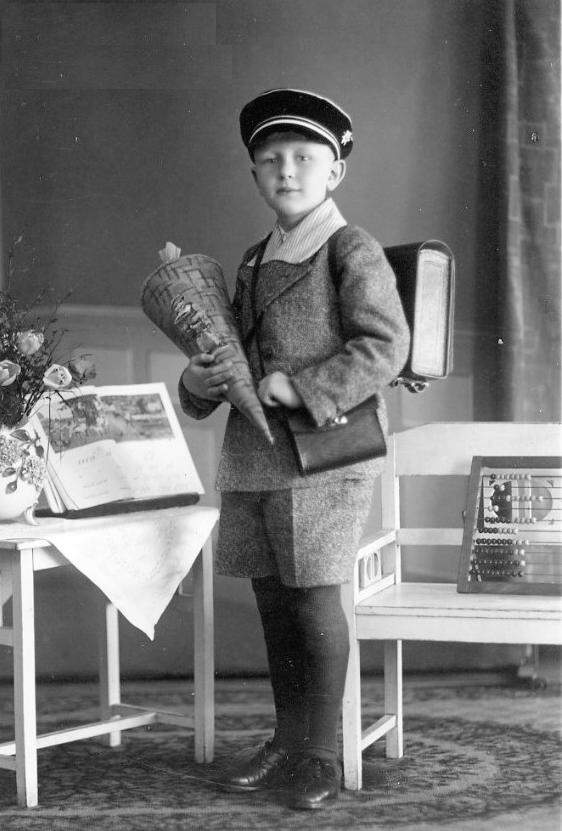
German Education: Supplies and Equipment

Figure 1.--Here we see a German biy with his satchel. Note the opened book on the table. It looks like a beginning reader. Also notice the abacus. A German reader tells us that the children did not take abacuses to school. Note that it is too big to fit in his satchel.
|
|
German boys had satchels and cases to take their supplies and equipment to school and we rarely see the supplies and equipment that they carried to school and used there. The major uitems of course were books. Younger boys had slates in their satchels. This could be used rather than paper at school. Note the rags and sponges hanging from the satchels. These were to clean the slates. There must have been chalk to use on the slates. Boys also had copy books. tThey used pens that were dippened in ink wells. Copy books were more common in Europe than America. I am not sure precisely how they were used. Some boys may have had fountain pens. Some classes has abacuses. We are not sure if the children brought abacuses to school in their satchels. Presumably there were also rulers and protractors.
Chronology
The school equipment used by primary school children before Workd War I was veey limited. We do not yet have much information here. We have more information on the inter-War era, both because of the photographic record and reader comments. The pupils still had very basic supplies and equipment which was very similar. There was in the inter-War era a "reform" with new ideas how youngsters should learn basics in school. This gradually resulted in more school supplies.
A reader writes, "When I started school, 1941, we all had slates, rags, and sponges."
And one book,
the "Fibel" (spelling book), not much more. For special dates, a box with water
colours for painting, or clothes and shoes for gymnastics (usually in a separate bag).
Soon, a book for arithmetic exercises was added; a book for singing; when written
exercises started, a paper note-book for class-composition/classroom-test.
Not much more."
Of course in the final years of World War II nd the immediate post-War era, virtually mothing was availavle for the children. And for that matter, many city children did not even have schools to attend.
A reader tells us, "I began secondary school/gymnasium after the War. Our school had been damaged, but at least we had a school. We no longer used slates. We had a number of paper note-books and text-books for the different fields, math,
foreign languages, geography, natural sciences etc.
We got text-books (in English) from army education for the English course and for elementary physics. For our first English/German dictionary we had to collect waste paper. In history, up to about 1949, the teacher dictated the facts of Greek and Roman history which we copied down. Text books were not available. Books that were available did not touch on modern developments." This all changed in the 1950s as a result of the German Economic Miracle.
Specific Equipment and Supplies
German boys had satchels and cases to take their supplies and equipment to school and we rarely see the supplies and equipment that they carried to school and used there. Of course this depended a great deal on the academic level as well as the time period.
Books
The major uitems of course were books. Books wee expensive and fairly limited before World War II. Older Germans will remember their "Fibel" spelling books. Only at the secondary level did the children begin to get more books.
Slates
Younger children in primary schools had slates in their satchels. This could be used rather than paper at school. Note the rags and sponges hanging from the satchels. These were to clean the slates. There must have been chalk to use on the slates. Slates were extensively used before and during World War II. After the war they rapidly went out of fashion. Here a factor was that paper, espeilly in terms of family income, became less expensive.
Copy Books
Boys also had copy books. They used pens that were dippened in ink wells. Copy books were more common in Europe than America. I am not sure precisely how they were used. At a time when text books were less available, teachers would dictate to the class and the children would copy down the information in their copy books which of course is why they were called copy books. I ever remember doing this in America during the 1950s when I went to school. Perhaps it was done earlier.
Pens and Pencils
Some boys may have had fountain pens.
Abacuses
Some classes has abacuses. We are not sure if the children brought abacuses to school in their satchels. A German reader tells us, "The abacus was not widely used in German elementary schools. It was much more common at home for pre-school introduction to numbers and simple arithmetic. I had one in the early 1940s included in a small black-board (50 cm x 80 cm) in a wooden frame/stand. I camecfrom a middle class family. This was not something most children commonly had."
Rulers and Copases
Presumably there were also rulers and protractors.
HBC-SU

Related Chronolgy Pages in the Boys' Historical Web Site
[Main Chronology Page]
[The 1880s]
[The 1930s]
[The 1940s]
[The 1950s]
[The 1960s]
[The 1970s]
[The 1980s]
Related Style Pages in the Boys' Historical Web Site
[Main school uniform page]
[Main country page]
[Long pants suits]
[Short pants suits]
[Socks]
[Eton suits]
[Jacket and trousers]
[Blazer
[School sandals]
Navigate the Boys' Historical Clothing School Uniform Pages
[Return to the Main German school page]
[Main School Uniform Page]
[Australia]
[England]
[France]
[Italy]
[Japan]
[New Zealand]
[Scotland]
[United States]
Navigate the Boys' Historical Clothing Web Page
[Introduction]
[Activities]
[Biographies]
[Chronology]
[Clothing styles]
[Countries]
[Bibliographies]
[Contributions]
[FAQs]
[Glossaries]
[Images]
[Links]
[Registration]
[Tools]
[Boys' Clothing Home]
Created: 7:09 AM 5/28/2009
Last updated: 7:09 AM 5/28/2009




